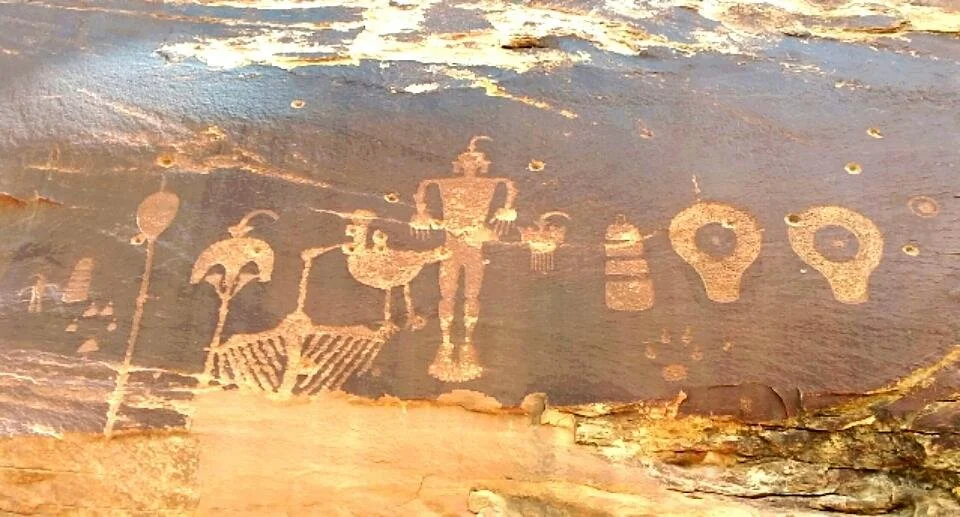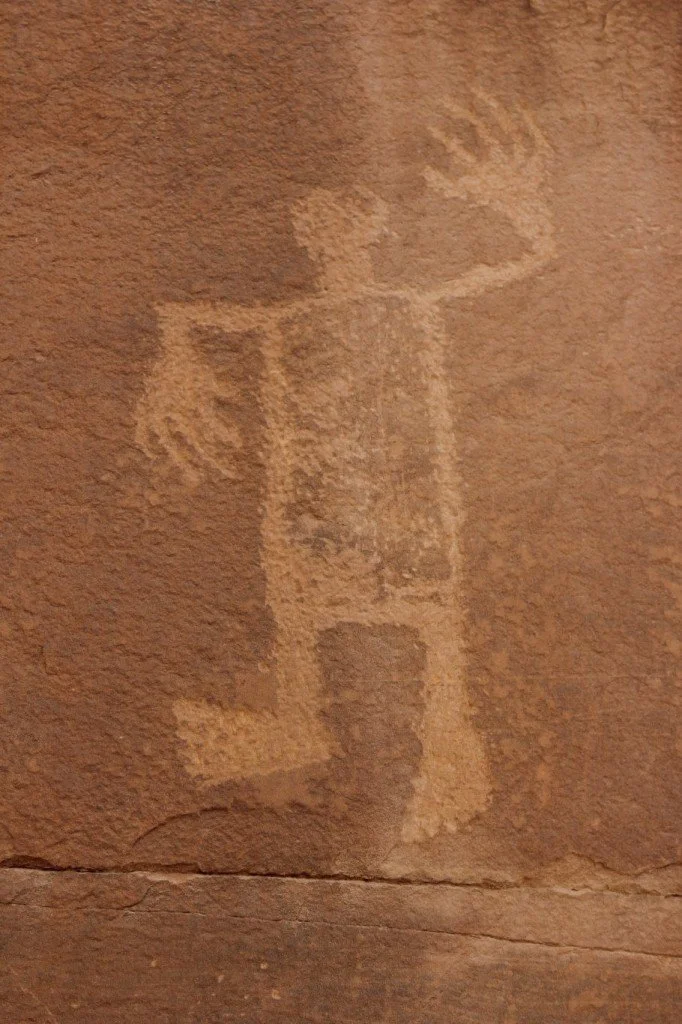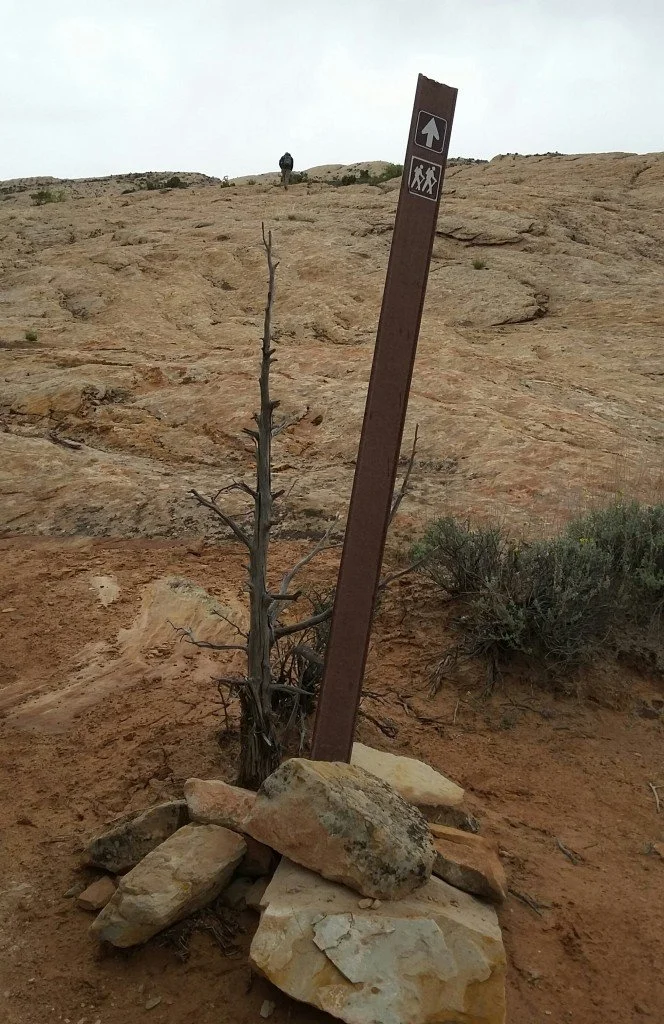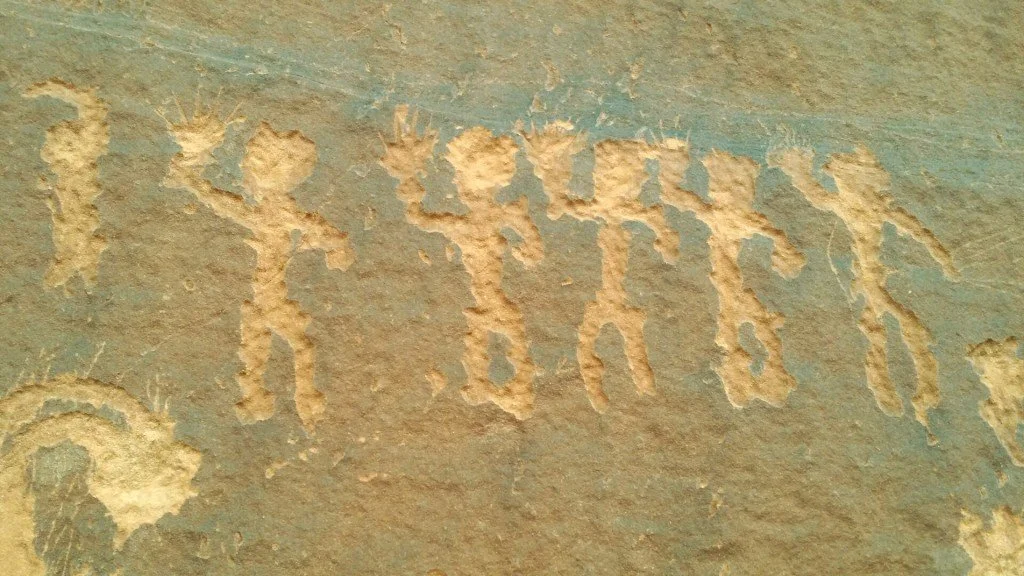Wolfman Panel, Petroglyphs, and A Lost Story
"Did you get a good photo of the wolfman?" I ask, uttering a sentence I never thought I'd hear coming from my mouth.
"I think so," my husband replies as we shuffle through the photos on our phones. The light of full-sun made capturing the petroglyphs on the sandstone rock difficult.
Three of us - Kevin, our friend, Pete, and I - have cameras, and between us, we have captured all the ancient petroglyphs at this site. Pete's son, Ben, is content to record the scene to memory without a camera.
We snapped pics of a sand crane. Plants. A shield. Several curious objects. And an anthropomorphic drawing of a human-wolf creature from which the panel derives its' name.
Before moving to the Southwest, I used the words petroglyph and pictograph interchangeably, not realizing the words described two different forms of ancient rock art. Petroglyphs consist of designs that are scratched or chiseled into the surface of a rock. Pictographs are created when art is painted onto the surface.
The petroglyphs at Wolfman Panel are one of several ancient drawings we hope to see on this trip.
A bone-jarring jolt causes me to peer over my shoulder to check on our gear in the back of the truck. Pete drives around one more huge pothole on a dirt road located in Cedar Mesa, Utah. We are traveling a vast sandstone ridge that stretches over one hundred miles long and one mile wide, a rugged scar lifted above the surrounding plains. This narrow edge of sandstone is home to countless ruins and artifacts from the Ancient Puebloan people, a bit of history we plan to explore on our three-day getaway.
We have packed more gear than usual but with an 80% chance of rain and a 40% chance of snow in the forecast, we are taking no chances. At the last minute Kevin threw in an extra sleeping bag to insulate our bodies from the cold ground and the 30 degree nights as we plan to car camp in the area. That prediction didn't quite double our gear, but it did increase our packing by at least 50%.
On our adventures into the back country, we stick to the motto, "There is no such thing as bad weather, only bad clothing". Camping cold and wet lost its appeal over three decades ago.
After several stops and more miles on the teeth-jarring dirt road, we take a side turn-off for Procession Panel. No signs, parking lots, or bathrooms mark this as the trailhead. Only Pete's GPS and a single mylar stake to the southwest of the vehicle gives us any indication we are at the correct location. We sling backpacks on our shoulders and head across the slickrock, taking the trail to the right as it angles into Butler Wash, an area shaded by tamarisk, willows, and cottonwoods.
Once out of the wash, cairns direct us across the confusing slickrock to a sandstone cliff that towers over the trail. A steep climb takes us to our location - a panel of petroglyphs that extends more than fifteen feet in length.
179 human-like forms come from three different directions toward a central circle. Five figures face forward with torches raised. Several figures carry staffs. Two wear bird headdresses. Below the marching figures are bighorn sheep, deer/elk and snakes and other usual forms. People who study such things believe the rock art depicts a ceremony or a migration.
But.
Nobody knows for certain. No written language was added to the drawings, so all interpretation of the art is speculation.
The words to the people's story have been lost. Only a few illustrations remain.
A picture book on a sandstone wall.
A chiseled message on a rock face.
An art museum without walls.
Snapping a few more photos, I wonder if others have come here hoping to discover a hidden story in the ancient carvings. Perhaps, more importantly, I wonder if the observers have found themselves in the unwritten history.
Because don't we all, at times, struggle to find words?
I have experienced the loss of story in cancer.
But I know I am not alone.
A friend has lost her story in divorce. Another through chronic pain. Another in the natural order of the last child leaving home and the nest is empty. Another in a career change late in life.
Where will they discover new words? Where will I?
Is it possible to pick up a tool to carve into the wall of a new life story after so many difficult sentences and unplanned chapters? After loss. After grief. After change.
So. Much. Change.
In the shadow of this silent people, is it possible to discover a legacy larger than words?
Is it possible for truth to stir in the most ancient story -- of a creator who has days yet planned for all that is good?
I believe this. I doubt this.
These are the thoughts and questions I ponder later that evening, as we pitch our tent among giant boulders that serve as a shield to the whipping wind. The rain fly snaps like a tethered sail and I wonder what new things we will discover in the morning.







